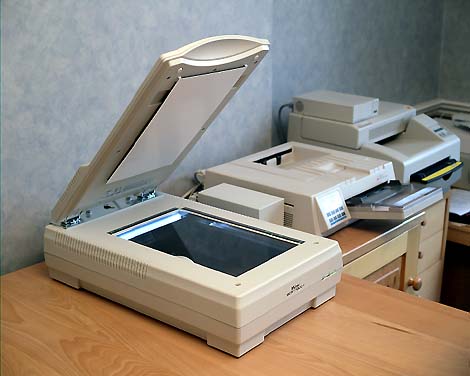
But what is the Nikon ScanTouch itself? The first answer is stunningly good - read on...
The ScanTouch is a physically large and heavy scanner. It most closely resembles earlier Epson models in this respect, and in details of control placing, platen design and its transparency adaptor lid. However, it is not identical and bears only a Nikon label. Unlike the top-end Epson models it only uses three-pass scanning; some Epson models can also work single-pass.

Like Epson's new and more compact GT9000 the Agfa Arcus Plus, the ScanTouch converts the image using 10 bits or 1,024 greyscale steps per color channel. The final image data used by image manipulation, presentation and DTP programs is only 8-bit, or 256 grey steps per channel. 10-bit analog-to-digital conversion allows contrast correction curves and brightness control to be applied with less noticeable loss of quality.
It is often claimed that 10-bit conversion is not sufficient, but our experience is that the hardware has a great effect. You can design an 8-bit scanner which produces excellent shadow detail by default, or a 10-bit scanner which does not do so unless you apply a correction curve. What really matters is the brightness or density range the scanner can cope with.
Here, the ScanTouch is no better than most others. It will just handle a good fibre-based print developed to maximum black density, and has no problem with any type of color print. The Photoshop plug-in for Macintosh is PowerPC compatible, and despite an annoying 'scanner has been reset' dialog every time it is first opened, provides comprehensive control with accurate previewing of brightness, sharpness, gamma, auto-levels and other key functions.
Its good points include instant landscape orientation without loss of speed, a large preview window, and the ability to save output resolutions which can then be used rapidly with a final size or percentage scaling control. The histogram window will be instantly familiar in appearance and use to any Photoshop user, and the three color channels can be independently adjusted. In fact, ScanTouch offers far more compensation and correction than any normal user will ever need.
ScanTouch takes about twelve seconds in total to display a full-color 8.5 x 14" preview, and doesn't cut off half an inch like many models do; instead, it scans slightly beyond the platen glass area, so you can place originals right up to straight edge and not lose a millimetre. It then takes almost no time to scan. A 35 megabyte scan for an A3 bleed spread was initiated, scanned and fully displayed by Photoshop in just a fraction over two minutes. This compares with between ten and forty minutes on other scanners.
Interpolated sizes caused no speed or quality loss and had no aliasing or blurring. This is almost unheard of; I suspect it is due to Nikon's use of 565 x 1200dpi as the scanning matrix, resulting in a non-factorial interpolation of data, avoiding regular artefacts while trading off against a slight loss in sharpness. Dust did not leap into focus, and the lighting angle was not sensitive to print surface texture. This is called getting the design right.
Most regular magazine repro scans were previewed, cropped, adjusted, and fully scanned in under one minute. It would be possible to scan and save to disk thirty 4Mb 24-bit color files per hour from mixed print sizes.
The transparency lid only accepts up to 4 x 5 inches, with an oversize cold light diffused source to work landscape or portrait. It is far slimmer than full 10 x 8" scanning lids, and the hardware interpolation to 1200 x 1200 (software to 2400) allows usable scans from rollfilm. The speed is unimpaired; the 10-bit conversion gives a clean, usable image with decent shadow detail only defeated by heavy Fujichrome Velvia slides with their d-max of almost 4.0 (an extremely dense maximum black). Best of all, the lid can be left in place, its glass protected by a snap-fit white pressure plate (see photo) just like the regular plain lid. Reflective print scanning is thus totally unaffected by having the tranny lid in place.
At PHOTON, we were due to test a ScanTouch but Nikon's UK PR agency never delivered one. When an offer from The Vision Corporation Ltd arrived to have one on sale or return, we accepted, to our cost - the equipment proved so productive and proficient that it had to stay. A week later they got their £1,495 plus VAT for the kit with Photoshop LE. I could have bought £200-300 cheaper from almost any other dealer, had a new one rather than a decidedly demo model - and avoided getting 'touched' for a £45 surcharge for my credit card transaction, which I had not agreed to beforehand.
But... the ScanTouch could not possibly be returned. It transformed life because NO size of scan, no matter how large, caused any significant disruption to work; two minutes is very, very much shorter than twenty minutes.
The quality is also higher than any other flatbed scanner we have used - including two which originally had price-tags of over £10,000 and over £5,000 respectively. We do not use the Colorsync profile feature as this totally ruins the quality of the scans, but that is a common experience; I have yet to meet anyone, apart from owners of inkjet desktop color printers and color laser copiers, who found any of the major 'color management systems' to be of any use whatsoever. Even Agfa's FotoFlow with its targets you scan and calibrate produces inferior color after calibration compared to a raw scan with slight gamma adjustment and accurate highlight/shadow set-up.
In Britain, The Vision Corporation's sale-or-return scheme is still operating, and you try the ScanTouch at your own risk - call Julie Ashworth at The Vision Corporation on (+44) 1734 730911. I don't know if similar schemes exist in other countries.